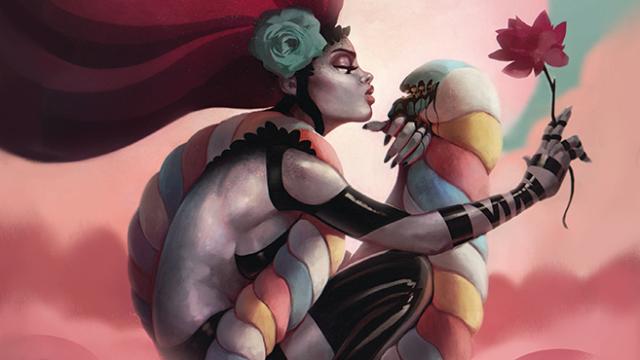Months ago, DC Comics killed the version of Superman that comics legend Grant Morrison re-introduced as a jeans-wearing, fatcat-stomping crusader. But Morrison isn’t bitter. He’s got more cool shit to make. Like a toilet that travels through time picking up cool bands before they lost their mojo.
Grant Morrison’s best known as a psychedelically creative writer, the guy behind modern-day classic runs on Superman, Batman, the X-Men, and Justice League. His original creations like We3, The Invisibles, and Nameless also just happen to be some of the most memorable comics reading for millions of comics fans. But lately he’s been steering one of the most venerable anthologies in the science-fiction/fantasy world, serving as .
Next week sees the release of Heavy Metal #282, a science-fiction themed issue with contributions from Donny Cates, Enki Bilal, Morrison himself, and others. (Exclusive previews from the issue can be seen throughout this post.) I spoke to the Scottish writer this morning to talk about the next issue of Heavy Metal and he told how he does the whole editor-in-chief thing, his feelings on the death of the New 52 Superman, and why we’ll all look like Dr. Strange in the near-future.
io9: What was your interaction with Heavy Metal as a younger man?
Grant Morrison: As I’ve had to admit before, to my shame, I wasn’t a big fan of Heavy Metal at all when I was younger. I remember when it came out I was really impressed with the artwork, the Moebius stuff and [Phillip] Druillet and those guys. Although I loved the artwork, I just hated the stories. I was a real snob about stories; I kind of grew up on American comics and expected certain things to happen. So, for me, I was always kinda let down by the stories.
At the same time, I was also working on [2000 A.D.,] a kind of British version of Heavy Metal which was a lot more amateurish but still had some good stuff in there. And that was my first job in comics. So we almost felt that Heavy Metal was some kind of competition to us.
I was a little punk kid at the time and I kind of felt that Heavy metal was too hippy for me. My first interactions with it were slightly negative even though I loved the artwork. I did get into it once Richard Corben started doing his stuff in the American version. So, a slight love/hate relationship. That’s what I’m trying to tap into. And also a lot of those influences from the ’70s, whether it’s Marvel black-and-white magazines, Warren comics, and a bunch of European books. There’s a lot of stuff that I’m trying to reach back to in order to get an aesthetic or a flavour.

You’ve been editing Heavy Metal for a few months now. What are the differences between putting your own vision on the page and helping others execute it? What’s the process of Grant Morrison being an editor of something?
Morrison: Basically we get a lot of submissions and my wife Kristan and I go through them. She’s been pretty intrinsic to all this as well, because I wanted to have a woman’s voice in the magazine that was strong and bold and exciting. We split a bottle of champagne, look through the submissions, and decide which ones we like. At the same time, I’m also bringing in artists like Benjamin Marra and people I’ve wanted to work with, along with discovering new people from the submissions pile. The whole thing’s all actually quite fun and usually just an afternoon’s drinking.
Many fans have experienced your creativity in mainstream superhero universes, which allowed you to experiment with what you characterised as living, evolving histories, and continuities. Is the soil rich enough with Heavy Metal for you to do the same?
Morrison: It’s very different, in the sense that Heavy Metal‘s not really a universe in the same way that Marvel and DC are universes, y’know? With certain rules and certain characters that recur. Unlike the Marvel or DC Universe where the company controls the characters, at Heavy Metal, the artists control the characters. And it’s not one overarching umbrella of a universe so, no, it doesn’t have the same sensation of “you’re actually interacting with a syncretic entity” like Marvel or DC does.
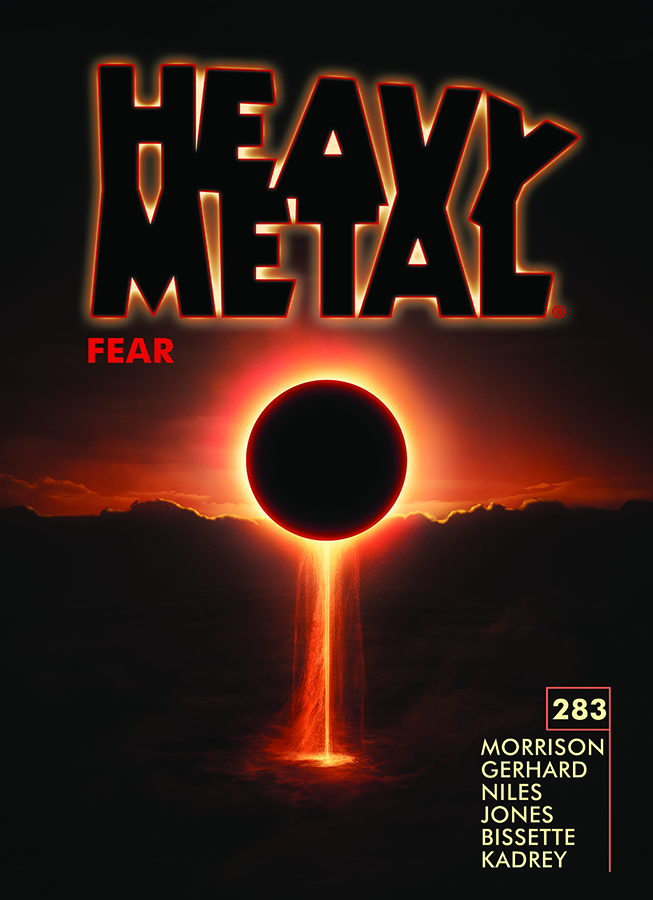
But what I love about Heavy Metal is the showcase quality of it, that you can only get in anthologies. It has its own aesthetic and its own distinct feel but, at the same time, you can get a lot of different appeal in there. I’m loving being able to write different kinds of stories — science fiction one, funny ones, horror ones — which has been quite a peak of creativity for me after dealing with specific cultural icons like Superman and Batman.
The Industria story you wrote for issue #282, drawn by Rian Hughes, feels particularly unfettered. You’re known for throwing ideas out there fast and hard but this felt like triple the speed and triple the density. Where did that come from?
I’ve been trying to do different types of stories in each issue and this was the scifi issue and I wanted to do something a little different. The notion I had was that it’d be really fun to do a science fiction comic book version of the Kardashians, like those reality shows on E!. Because my own life just involves string behind a desk and writing, there’s not much going on. But my wife Kristan has been involved in a bunch of music festivals and having a busy time. I thought wouldn’t it be fun if I took her life and then used as the basis for a super-reality show?
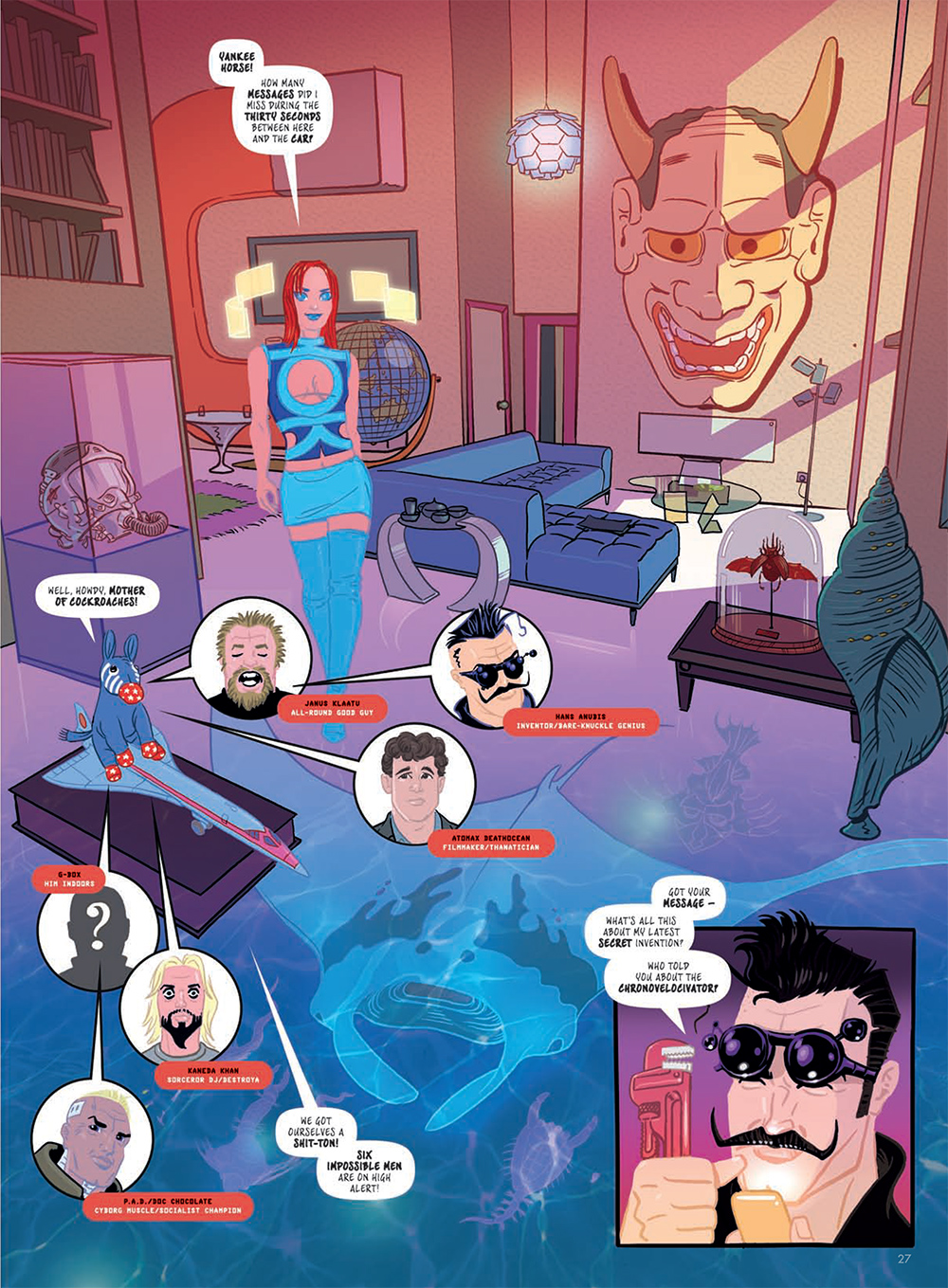
I took everything about her life and dialed it all up — the cats, the friends, and the festivals she was involved in — and threw in these scifi touches and elements. It’s quite an interesting story in that it’s based on somebody’s real life but really distorted through a bizarre, pop bubblegum science fiction lens. It’s also about the Discordian goddess of chaos Eris; that’s why Industria’s got red hair and the apple with the key on it. There’s a lot of subtext in there about Batavian mythology and Discordianism and the stuff I’m usually interested in. Rian and I tried to pack all this material into a fast, pop, cartoonish story which at the same time has depth because it’s based on someone’s real life.
How do the artist galleries come about in each issue?
Morrison: Well, for the first issue that I did, we had material from my friend Tom McElvain’s gallery, The Century Guild. There were a lot of paintings there from Gail Potocki, who’s this brilliant modern symbolist painter. She did the painting of me that was in [Heavy Metal #280].
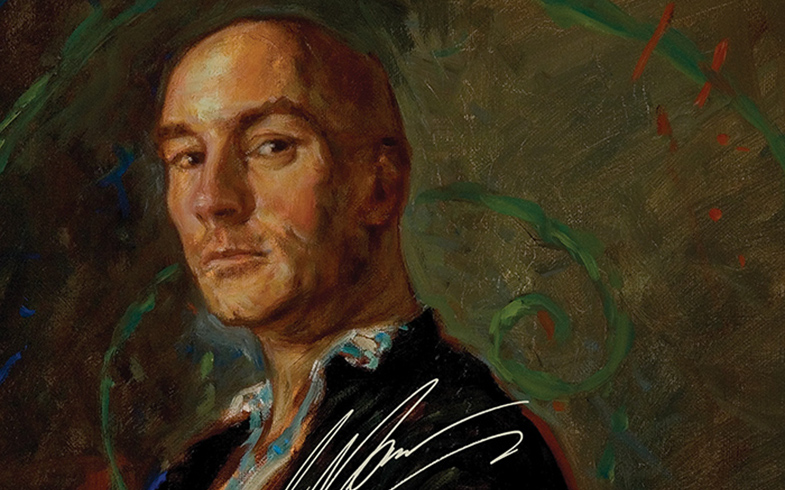
So, in the case, it was a friend who’s sort of the king of the Los Angeles alternative art scene. Otherwise, it’s contacts from the different editors or [company co-CEO] Jeff Krelitz himself. He checks out a bunch of galleries all around the country, finds things and we feature them. We’re also reaching out to artists to provide their own personal galleries of whatever they want us to showcase.

I haven’t read Heavy Metal in a long time but I was struck by how intellectually chewy some of the stories in this issue were. “Gavrilo C-914” by Pahek was really fun and great in how it looked at how socioeconomic class conflict gets turned into a perverse sort of entertainment…
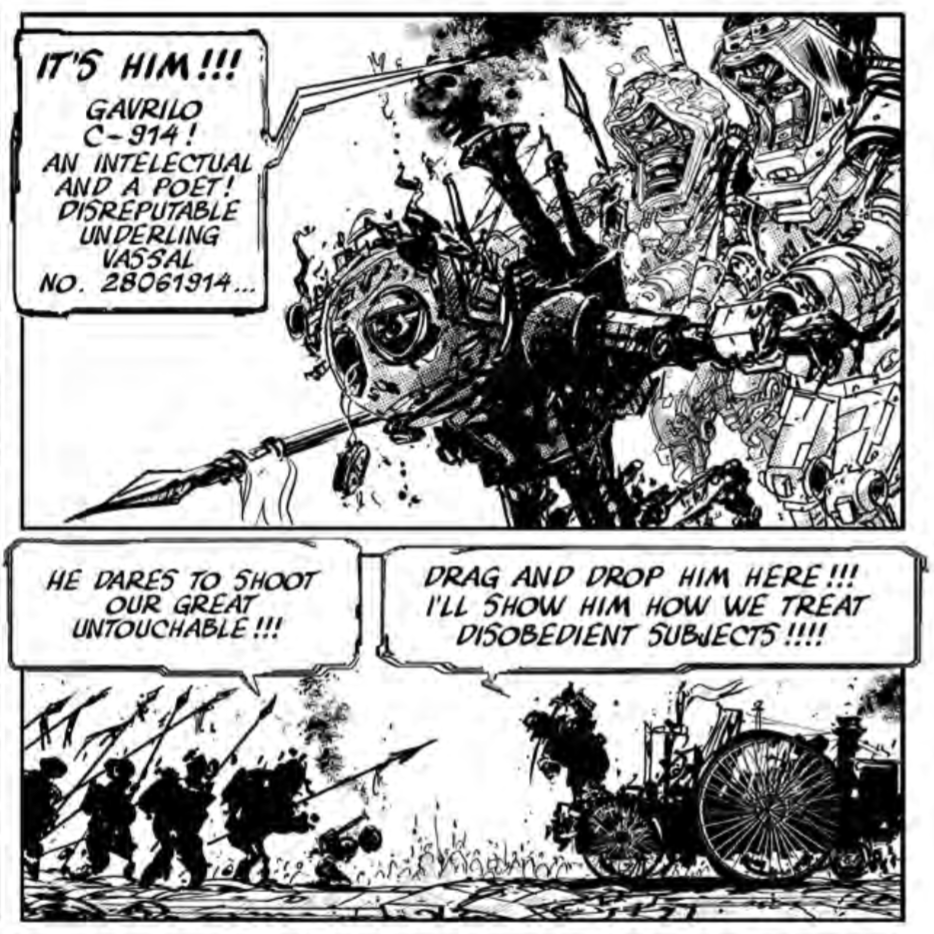
Morrison: And along with that it hits on Eastern European politics and the violence in the Balkans. I love that art style because it’s kind of every great 2000 A.D. artist mashed into one, like Kevin O’Neill meets Mick McMahon. I thought it was a great piece of work.
You’ve done great work yourself, including the relaunch of Superman and Action Comics for the New 52 five years ago. DC Comics just killed your Superman, though, and I wanted to see if you had any reaction to that whatsoever.
Morrison: It’s sad to see him go, y’know? I liked that version of the character but this happens all the time; you just have to expect it. Someone who will come along — in 20, 10, five years time or however long it takes — who grew up on that and will bring that [Superman] back and that will be part of the next big event. “The New 52 Returns to Fight the Old 52” or whatever. Once you’ve created things and put them out there, they have a life of their own anyway. It’s part of the inevitable way the comics run. Particularly now with all the event-driven storylines and constant renewals of universes every couple of years, it’s only to be expected. I thought he was pretty cool. I liked that version of the character. I enjoyed writing him.


The thing that I’ll always love about that version of the character is the singing spaceship. Something about that is so emotional and true… I love it.
Morrison: Well, thank you.
I know Gerard Way is sort of a disciple/acolyte/friend of yours. How does it feel to see DC giving him his own room to play in with his Young Animal pop-up imprint, including some of the comics series you used to work on?
Morrison: I think it’s great. He’s a fountain of ideas, Gerard is. He’s got so, so much going on. We did speak about it. He actually came to me and asked for my blessing to do Doom Patrol. [laughs] I said you don’t need my blessing. Doom Patrol’s out there; it’s open to anyone. I know he loves the characters and it’s great to see someone who cares about it coming in to do it. And also, because he brings a ready-made audience, it means that he can take a few more chances and do things that are a bit more experimental. I think it’s great and I’m looking forward to seeing how it all works out.
You’re working on Brave New World for SyFy. So much of what’s in that novel has faded into the background as stuff we take for granted insofar as how we imagine science fiction or fiction that comments on the world. How can you make that feel fresh again?
Morrison: I have to invoke NDA [laughs] because at this point, if I told you how we were making it fresh, it wouldn’t be good for me. But, for Bryan Taylor and I, that was the problem we had to solve. Now we actually live in a world where people use narcotics freely to change their states. We’re caught up by all kinds of entertainment media almost like the Feelies in the book. We’re ruled by a benevolent dictatorship that’s gently guiding us by conditioning and adverts and programming to be the way they want us to be, which is pretty docile.
So it’s close. The fact that we’re moving into the era of virtual reality, augmented reality and mixed reality moves us even closer to [the reality of Brave New World]. Those are the things had to think about. We came up with a peg that everyone liked because we actually did find a new way to present all that material and to re-think it and to keep it as contemporary. [Aldous Huxley] wrote the book in 1932 but he was talking about the now where we live. We’re using that as satirical mileage, the fact that we practically live in the Brave New World.
You mentioned VR. Have you messed with any VR at all? For a guy with your proclivities, I imagine it must be pretty interesting. Have you touched anything cool?
Morrison: Yeah, I’ve been a consultant with Magic Leap. They’re way ahead of the curve with the augmented reality stuff. They’re working with Disney and Industrial Light & Magic. I’ve actually been sort of friendly with them and the boss Rony Abovitz for a good two years now. I knew what was coming and I knew it was gonna be cool. We’re working on material for them and they’re still in development but the take they have got on this is so far in advance of everyone. Their technology is completely new; it doesn’t rely on stereoscopic projection. It’s quite mind-boggling. To me, it’s not just the next big thing. It’s an advancement for human/machine fusion. It’s going to be very unusual.
As someone who’s covered video games and technology before, the stuff that they’re showing, it’s so hard to believe it’s real. It looks insane.
Morrison: It is. It’s quite astonishing. But it’s the way that it affects the mind that I find very interesting. You see virtual objects but, if you put your hand out, your hand goes behind the object. Your brain is fooled.
Beyond that, it’s going to be how everyone will interact. Everyone with an endless amount of information projected onto their world. We’ll be playing games, have sprites who can send emails and little dragons on our shoulders. Everyone will be walking down the street tapping at haptic keyboards in five years time; we’ll all look like Dr. Strange! It’s going to be quite fascinating. I think it will be a real revolution in the way people think and behave. Socially, I’m very excited about it.
